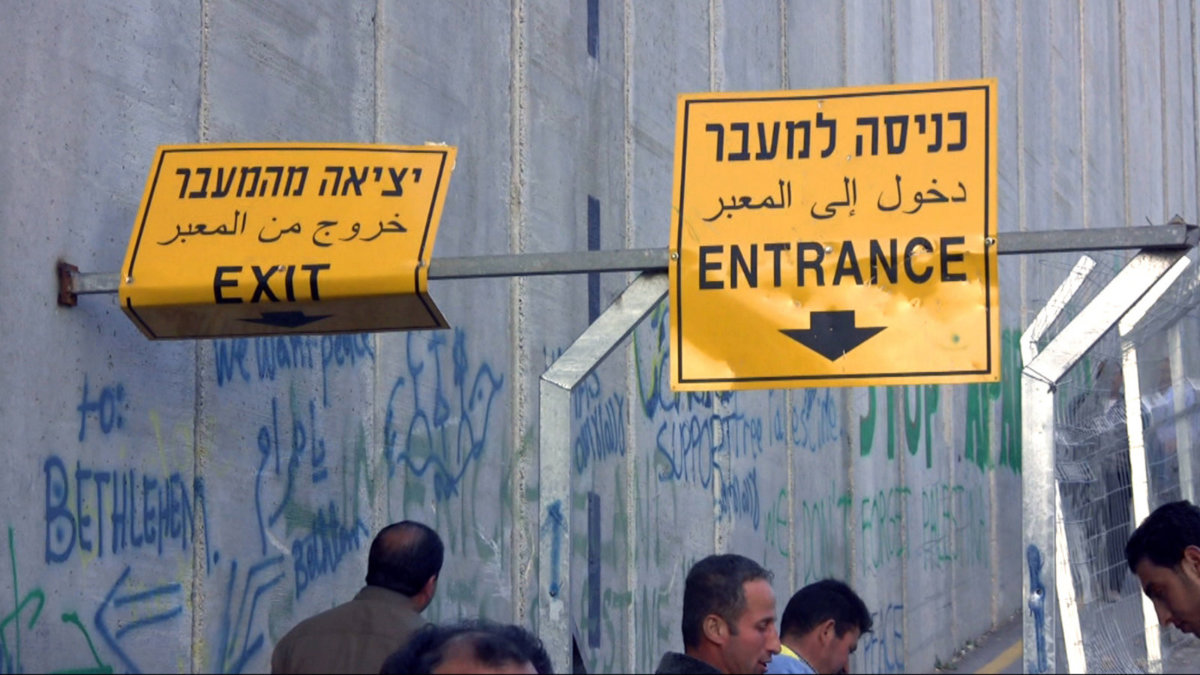by Elizabeth Heyes
The word Apartheid may initially conjure images of the half-century long regime which saw the segregation and brutal discrimination against the non-white inhabitants of South Africa, however it has increasingly been noted by historians, politicians and activists that there are striking similarities between the policies of the Afrikaner government in South Africa between 1948 and 1994, and those of the state of Israel. In Leeds PFF2020 documentaries Roadmap to Apartheid and Budrus, we are delivered incredible detail, shocking comparisons, unflinching testimony, and a case-in-point look at the aims and impacts of these policies.
As the title suggests, Roadmap to Apartheid immediately underlines the disturbing symmetry between the South African Apartheid regime and the division between Palestinians and Israeli settlers which is now an undeniable fact in Israel. Far from concentrating solely on the well-documented clashes that consumed South Africa in the 80’s and 90’s, the documentary traces the origins of the state of South Africa right back to its source. The white settler colony of mainly Dutch and German descent faced discrimination from British colonial rule, and the Calvinist Christian comparison of their predicament to that of biblical figures including Abraham encouraged the proclamation that they were a chosen people with a right to their promised land. “The Great Trek” beginning in 1836 saw migration en masse to an area of purportedly uninhabited land, in order to live free of persecution and with the possibility of self-determination.
If this rhetoric sounds familiar, it is not lost on the South African, Palestinian and Israeli figures interviewed in this documentary. The myth of the “land without a people for a people without land” is swiftly dismissed and the consequences of this migration, its land-grabbing policies and its segregation of native and Boer communities are plain to see in this documentary’s impressive reel of archival material from the Apartheid regime, mirrored by almost identical footage taken in Palestine since the mass-migration of the global Jewish population after the founding of Israel in 1948.
What is particularly remarkable about this documentary, though, is its highlighting of the systematic detail with which Israeli and Apartheid-era South African policies have appeared to intentionally disrupt the lives of black South Africans and Palestinians, and in a far more aggressive way than can be excused by the desires of Boers and Israelis to establish their own state and security. The revelation that Israel in fact supplied the South African Apartheid regime with arms, breaking from the majority of international powers who had imposed embargoes, is a grim, if not unexpected, twist in the tale.
Land-grabbing and annexation emerges as the central focus in Roadmap to Apartheid. The dispossession or demolition of homes and invention of oxymoronic categories like “foreign natives” and “present absentees” to contest inhabitants’ rights to their own homes are just two of the ways that this is achieved.
Though the clarity with which Roadmap to Apartheid communicates the apparently calculated nature of Israeli policy is a great feat, it does benefit for being watched alongside an in-depth exploration of the human stories attached to the conflict. This is provided in the story of Budrus, which is to some extent a microcosm of the wider issues of land ownership and the regulation of in the West Bank particularly.
The documentary focusses on the village and its inhabitants, who were threatened between 2003-2004 by a barrier proposed by the Israeli government for security purposes. Overstepping the 1949 Green Line which separates the Palestinian territory and the state of Israel, the barrier threatens to carve up the Palestinian village’s land, running right through its cemetery and uprooting the olive groves on which its inhabitants’ livelihoods rely.
The financial cost as well as the emotional impact of separating the inhabitants of this agricultural village from around 90% of their land is clear. Husneia el-Abed Hassan, an elderly resident describes her grief at the prospect of being separated from it, “A tree is a source of life, and one raises it just like a child. And it is equally dear to you… Death, stealing the land, and uprooting the trees are one and the same.” In retaliation to the annexation of their land, Ayed Morrar, a former Fatah activist, proposes non-violent resistance protests which grow to encompass the whole village, men and women, and eventually sympathetic Israelis and international activists.
More than simply documenting the events from the perspective of Palestinians, Budrus explores the dilemma it creates for Israeli soldiers. Yasmine Levi, says she intentionally sought a position with the Border Police for its assertive action on the ground and the greater equality it offers for female soldiers. Ironically, these are two aspects that cause her the most difficulty in Budrus as she struggles to reconcile her military status when faced with the increasing presence of women in the village’s non-violent protests. The women of the village seize the connection that their shared gender gives them with Yasmine, the only female member of the Border Police that appears in the documentary. We see the women’s struggles, but there are also moments of humour. It is impossible not to laugh when Yasmine describes how they would joke telling her she need only drop her gun and they will set her up with their sons and provide her with sheep.
In many instances, we see the policies described in Roadmap to Apartheid in action. The destruction of property, regulation of movement and excessive force in the face of peaceful demonstrations that South African witnesses to Apartheid describe are immediately evident as we observe daily life in Budrus.
Despite this, Morrar remains committed to non-violent resistance which wins the attention and support of Israeli activists who condemn the government’s and military’s imposition, and who strategically place themselves at the font line (the implications for a soldier who tear gasses an Israeli citizen as opposed to a Palestinian are far more serious). The relationship this facilitates is touching. Iltezam, Morrar’s daughter, reflects on the experience saying, “They’re not all soldiers, they don’t really hate us”.
These documentaries give an extremely powerful illustration of the ways in which certain policies and practices have resulted in Israeli annexation of land and the deepening of divides between its peoples. Watching these works as a pair gives a well-rounded understanding of the conflict’s history without dehumanising those who continue to live it. Though both leave the ultimate question of a solution to contested land ownership and the conflict as a whole unresolved, they underline in their analogy of Apartheid, which fell in 1994, that there can be a solution – and the first step towards this must be the fundamental recognition of the humanity and equality of all.









